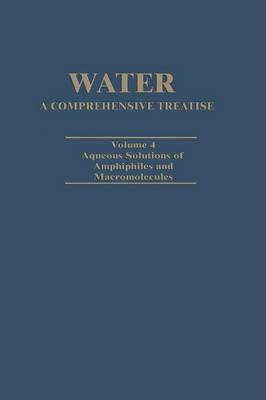Water
3 total works
Since the publication of the previous volumes many new aspects of the physical and life sciences have been developed in which the properties of water play a dominant role. Although, according to its preface, Volume 5 was to be the last one of the treatise, these recent developments have led to a revision of that statement. The present volume and its companion, still in preparation, deal with topics that were already mentioned in the preface to Volume 5 as gaining in importance. The recent development of X-ray and, more particularly, neutron scattering techniques have led to studies of "structure" in aqueous solutions of electrolytes on the one hand, and to the role of water in protein structure and function on the other. Both these topics have reached a stage where reviews of the present state of knowledge are useful. The application of ab initio methods to calculations of hydration and conformation of small molecules has a longer history, but here again a critical summary is timely.
The role of solvent effects in reaction kinetics and mechanisms should have had a place in Volume 2 of this treatise, but, as sometimes happens, the author who had taken on this task failed tQ live up to his promise. However, since 1972 the physical chemistry of mixed aqueous solvents has made considerable strides, so that the belated discussion of this topic (by a new author) is built on evidence that was not available at the time of publication of Volume 2.
The role of solvent effects in reaction kinetics and mechanisms should have had a place in Volume 2 of this treatise, but, as sometimes happens, the author who had taken on this task failed tQ live up to his promise. However, since 1972 the physical chemistry of mixed aqueous solvents has made considerable strides, so that the belated discussion of this topic (by a new author) is built on evidence that was not available at the time of publication of Volume 2.
The chapters making up this volume had originally been planned to form part of a single volume covering solid hydrates and aqueous solutions of simple molecules and ions. However, during the preparation of the manu scripts it became apparent that such a volume would turn out to be very unwieldy and I reluctantly decided to recommend the publication of sepa rate volumes. The most sensible way of dividing the subject matter seemed to lie in the separation of simple ionic solutions. The emphasis in the present volume is placed on ion-solvent effects, since a number of excellent texts cover the more general aspects of electrolyte solutions, based on the classical theories of Debye, Huckel, On sager, and Fuoss. It is interesting to speculate as to when a theory becomes "classical." Perhaps this occurs when it has become well known, well liked, and much adapted. The above-mentioned theories of ionic equilibria and transport certainly fulfill these criteria. There comes a time when the refinements and modifications can no longer be related to physical significance and can no longer hide the fact that certain fundamental assumptions made in the development of the theory are untenable, especially in the light of information obtained from the application of sophisticated molecular and thermodynamic techniques.


